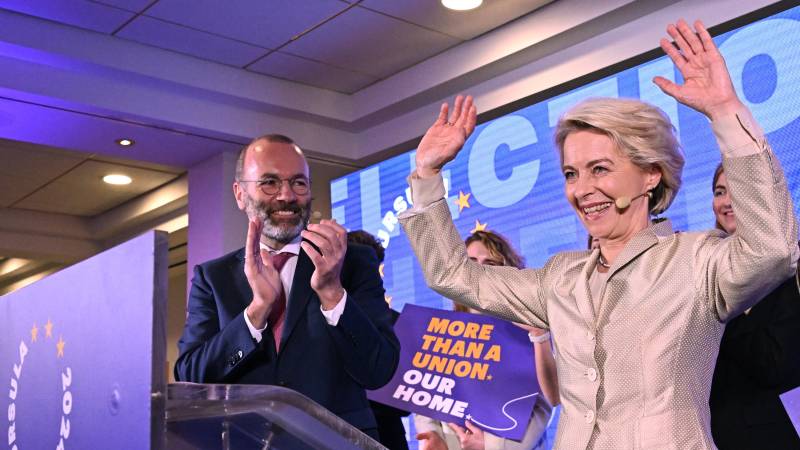
Even though the centrists kept their majority in the European Parliament after the election last week, far-right parties were able to make significant gains in France, Germany and Austria.
German Chancellor Olaf Scholz and French President Emmanuel Macron suffered humiliating defeats, with Scholz’s Social Democrats third in the German tally, and the National Rally in France securing twice the vote of Macron’s Renaissance party.
What were the results of the European elections?
Despite the dramatic gains for far-right parties in Germany and France, the center held relatively firm in the other EU member states and held onto the working majority. Ursula von der Leyen will therefore most likely continue as President of the European Commission until 2029.
von der Leyen’s center-right European People’s Party group (EPP) won 184 of the 720 seats, with the center-left Socialists and Democrats (S&D) claiming another 139.
With 16-year-olds eligible to vote in Germany, the far-right AfD (Alternative for Germany) party, which had invested considerably in a TikTok centered strategy to reach out to young voters, made huge gains among younger people.
The AfD won 16% of the youth vote, and emerged as the second largest party overall, trailing only the conservative coalition of the Christian Democratic Union (CDU) and Christian Social Union (CSU).
Chancellor Olaf Scholz’s Social Democratic Party (SPD) suffered their worst ever national result, coming in third in Germany.
The surprise was French President Emmanuel Macron announcing a snap election even before the official results were announced.
Why did Macron call a snap election in France?
On June 9, French President Emmanuel Macron dissolved Parliament and announced a snap election, catching observers and many within his own party off guard, even before the official results of the European elections had been tallied. The two-round election will take place on June 30 and July 7.
The announcement followed a complete rout of Macron’s pro-EU Renaissance party (formerly known as La France en Marche!) by the far-right National Rally (RN) in the EU parliament elections. The euroskeptic National Rally received 30% of the vote nationwide, compared to only 15% for Renaissance.
While announcing the snap election, Macron said that “far right parties are progressing everywhere in the continent… the extreme right is both the impoverishment of the French and the downgrading of our country… I cannot act as if nothing had happened.” He claimed that the results of the EU election were “not a good result for parties that defend Europe.”
Macron won his second and final term as President in 2022 against the National Rally’s Marine Le Pen, but his party lost the majority in French parliament. If the far-right RN emerges as the largest party in the parliament, Macron will have to announce RN party leader Jordan Bardella, Le Pen’s successor, as the French prime minister.
Macron’s unusual move is being debated as a calculated risk or a wild gamble. The President has a 65% domestic disapproval rating, and he has presided over a minority government since 2022. Many worry that an emerging far-right would not only wreck Europe’s support for Ukraine in the war against Russia, but also derail Europe’s climate policy.
What are the European elections?
The European elections are one of the world’s largest exercises of democratic franchise, second only to India’s general elections, where citizens of every EU state vote to elect members of the European Parliament, which is the EU’s only directly election institution. The EU’s nearly 450 million people are represented by 720 European parliamentarians (MEPs); nearly 350 million were eligible to vote in this year’s elections. The elections kicked off on June 6, and concluded on June 9.
The elections are essentially 27 national elections in tandem, as EU citizens vote for national parties and candidates. These politicians then join the larger European groups that form the parliament; these are largely organized according to political orientation.
Each EU state is apportioned parliamentarians in proportion to the size of its population. Germany, the largest state in the EU, has 96 European parliamentarians. The smallest states, such as Luxembourg, Malta and Cyprus, only have 6 members each.
The European Parliament does not select a government; instead, its most important function is to approve or reject members of the European Commission, which is the EU’s executive organ. EU parliamentarians also collaborate with the Council of the European Union, the ministerial level council of the EU member states and the European Council, which comprises the heads of the 27 EU member states’ governments.
What were the key issues heading into the polls?
The 2024 European elections have been dominated by security issues, against the backdrop of the war in Ukraine. Far-right populists and Euroskeptic parties were widely expected to make large gains, with far-right parties topping the pre-election polls in France, Italy, the Netherlands, Belgium, Austria and Hungary.
In Germany, the far-right AfD was polling at 15%, trailed by the conservative Christian Democratic Union (CDU) and Christian Social Union (CSU) coalition, leading the Germany Chancellor Olaf Scholz to issue warnings, pleading for voters to recognize the importance of European integration.
For voters, economic and social spending remain the dominant issue, with migration having fallen in the list of voters’ priorities for these elections.
